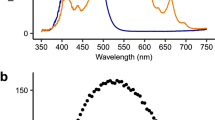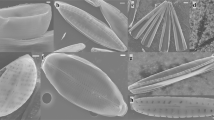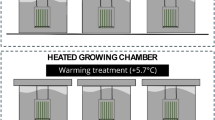Abstract
Reduction in sea-ice thickness and cover is expected to lead to earlier underwater light penetration and thus earlier onset of the spring bloom and a longer open water production in the Arctic. The goal of this study was to understand how these climate-induced changes in light and food regimes may impact the key zooplankton grazer Calanus glacialis CV. We studied this copepod’s metabolic response to starvation (filtered sea water; FSW) and algal food (Food) under two different light regimes (light vs. dark) when it was in dormancy (diapause) in winter (November) and active in summer (July). Respiration was measured as indicator of metabolism and was measured for 9 days for copepods exposed to: Dark+FSW, Dark+Food, Light+FSW and Light+Food. The in situ respiration in winter was three times lower than in summer. In winter, light was the main factor to increase the copepod’s metabolism to a level comparable with that of active copepods in summer, but respiration only remained high if food was present. In summer, it was the combined effect of light and Food that increased the respiration, although Food seemed more important than light with time. Copepods reduced their metabolism with time when food was absent, regardless of the light regime, probably preparing for diapause. These results suggest that C. glacialis can quickly adapt to a changing light and food regime in the Arctic, being able to wake up from diapause if light and thus food appear and postpone its diapause if the food availability is still favorable.


Similar content being viewed by others
References
Arnkvaern G, Daase M, Eiane K (2005) Dynamics of coexisting Calanus finmarchicus, Calanus glacialis and Calanus hyperboreus populations in a high-Arctic fjord. Polar Biol 28:528–538
Arrigo K, van Dijken G, Pabi S (2008) Impact of a shrinking Arctic ice cover on marine primary production. Geophys Res Lett 35:L19603
Bamstedt U, Tande KS (1985) Respiration and excretion rates of Calanus glacialis in arctic waters of the Barents Sea. Mar Biol 87:259–266
Blachowiak-Samolyk K, Søreide JE, Kwasniewski S, Sundfjord A, Hop H, Falk-Petersen S, Hegseth EN (2008) Hydrodynamic control of mesozooplankton abundance and biomass in northern Svalbard waters (79–81°N). Deep-Sea Res II 55:2210–2224
Comiso JC, Parkinson CL, Gersten R, Stock L (2008) Accelerated decline in the Arctic sea ice cover. Geophys Res Lett 35:L01703
Conover R (1988) Comparative life histories in the genera Calanus and Neocalanus in high latitudes of the Northern Hemisphere. Hydrobiologia 167:127–142
Engelsen O, Hegseth EN, Hop H, Hansen E, Falk-Petersen S (2002) Spatial variability of chlorophyll-a in the Marginal Ice Zone of the Barents Sea, with relations to sea ice and oceanographic conditions. J Mar Syst 35:79–97
Falk-Petersen S, Mayzaud P, Kattner G, Sargent J (2009) Lipids and life strategy of Arctic Calanus. Mar Biol Res 5:18–39
Gabrielsen TM, Merkel B, Søreide JE, Johansson-Karlsson E, Bailey A, Vogedes D, Nygård H, Varpe Ø, Berge J (2012) Potential misidentifications of two climate indicator species of the marine arctic ecosystem: Calanus glacialis and C. finmarchicus. Polar Biol 35:1621–1628
Gough WA, Cornwell AR, Tsuji LJS (2004) Trends in seasonal sea ice duration in southwestern Hudson Bay. Arct Alp Res 57:299–305
Hagen W (1999) Reproductive strategies and energetic adaptations of polar zooplankton. Invertebr Reprod Dev 36:25–34
Hagen W, Auel H (2001) Seasonal adaptations and the role of lipids in oceanic zooplankton. Zool Anal Complex Syst 104:313–326
Hernandez-Leon S, Ikeda T (2005) A global assessment of mesozooplankton respiration in the ocean. J Plankton Res 27:153–158
Hind A, Gurney SC, Heath M, Bryant AD (2000) Overwintering strategies in Calanus finmarchicus. Mar Ecol Prog Ser 193:95–107
Hirche HJ (1983) Overwintering of Calanus finmarchicus and Calanus helgolandicus. Mar Ecol Prog Ser 11:281–290
Hirche HJ (1996) Diapause in the marine copepod, Calanus finmarchicus—a review. Ophelia 44:129–143
Hirche HJ, Kattner G (1993) Egg production and lipid content of Calanus glacialis in Spring—indication of a food dependent and food independent reproductive mode. Mar Biol 117:615–622
Hirche H, Mumm N (1992) Distribution of dominant copepods in the Nansen Basin, Arctic-Ocean, in Summer. Deep-Sea Res I 39:485–505
Holm-Hansen O, Riemann B (1978) Chlorophyll-a determination: improvements in methodology. Oikos 30:438–447
Ikeda T, Skjoldal HR (1989) Metabolism and elemental composition of zooplankton from the Barents Sea during early Arctic summer. Mar Biol 100:173–183
Ikeda T, Kano Y, Ozaki K, Shinada A (2001) Metabolic rates of epipelagic marine copepods as a function of body mass and temperature. Mar Biol 139:587–596
Kahru M, Brotas W, Manzano-Sarabia M, Mitchel BG (2011) Are phytoplankton blooms occurring earlier in the Arctic? Glob Chang Biol 17:1722–1739
Kosobokova KN (1999) The reproductive cycle and life history of the Arctic copepod Calanus glacialis in the White Sea. Polar Biol 22:254–263
Lee RF, Hagen W, Kattner G (2006) Lipid storage in marine zooplankton. Mar Ecol Prog Ser 307:273–306
Leu E, Falk-Petersen S, Kwasniewski S, Wulff A, Edvardsen K, Hessen DO (2006) Fatty acid dynamics during the spring bloom in a High Arctic fjord: importance of abiotic factors versus community changes. Can J Fish Aquat Sci 63:2760–2779
Leu E, Wiktor J, Soreide JE, Berge J, Falk-Petersen S (2010) Increased irradiance reduces food quality of sea ice algae. Mar Ecol-Prog Ser 411:49–60
Leu E, Søreide JE, Hessen DO, Falk-Petersen S, Berge J (2011) Consequences of changing sea ice cover for primary and secondary producers in the European Arctic shelf seas: timing, quantity, and quality. Prog Oceanog 90:18–32
Maps F, Plourde S, Zakardjian B (2010) Control of dormancy by lipid metabolism in Calanus finmarchicus: a population model test. Mar Ecol Prog Ser 403:165–180
Miller CB, Crain JA, Morgan CA (2000) Oil storage variability in Calanus finmarchicus. ICES J Mar Sci 57:1786–1799
Perrette M, Yool A, Quartly GD, Popova EE (2011) Near-ubiquity of ice-edge blooms in the Arctic. Biogeosciences 8:515–524
Polyakov IV, Timokov LA, Alexeev VA, Bacon S, Dimitrenko IA, Fortier L, Frolov IE, Gascard J-C, Hansen E, Ivanov VV et al (2010) Arctic Ocean warming contributes to reduced Polar ice cap. J Phys Oceanogr 40:743–756
Renaud PE, Riedel A, Michel C, Morata N, Gosselin M, Juul-Pedersen T, Chiuchiolo A (2007) Seasonal variation in benthic community oxygen demand: a response to an ice algal bloom in the Beaufort Sea, Canadian Arctic? J Mar Syst 67:1–12
Rothrock DA, Yu Y, Maykut GA (1999) Thinning of the Arctic sea-ice cover. Geophys Res Lett 26:3469–3472
Seuthe L, Darnis G, Wexels Riser C, Wassmann P, Fortier L (2007) Winter–spring feeding and metabolism of Arctic copepods: insights from faecal pellet production and respiration measurements in the southeastern Beaufort Sea. Polar Biol 30:427–436
Søreide JE, Falk-Petersen S, Hegseth EN, Hop H, Carroll ML, Hobson KA, Blachowiak-Samolyk K (2008) Seasonal feeding strategies of Calanus in the high-Arctic Svalbard region. Deep-Sea Res II 55:2225–2244
Søreide JE, Leu E, Berge J, Graeve M, Falk-Petersen S (2010) Timing of blooms, algal food quality and Calanus glacialis reproduction and growth in a changing Arctic. Glob Chang Biol 16:3154–3163
Stroeve JC, Kattsov V, Barrett A, Serreze M, Pavlova T, Holland M, Meier WN (2012) Trends in Arctic sea ice extent from CMIP5, CMIP3 and observations. Geophys Res Lett 39:L16502
Takahashi K, Nagao N, Taguchi S (2002) Respiration of adult female Calanus hyperboreus (Copepoda) during spring in the North Water Polynya. Polar Biosci 15:45–51
Varpe Ø, Jørgensen C, Tarling GA, Fiksen Ø (2009) The adaptive value of energy storage and capital breeding in seasonal environments. Oikos 118:363–370
Wassmann P, Duarte CM, Agusti A, Sejr M (2011) Footprints of climate change in the Arctic marine ecosystem. Glob Chang Biol 17:1235–1429
Acknowledgments
We want to thank M. Daase, B. Niehoff, K. Bluhme and M. Graeve for their valuable help prior to and during the experiment in 2009, as well as H. C. Eilertsen for providing us with algal cultures. This study was funded by the projects CLEOPATRA I and II: Climate effects on food quality and trophic transfer in the Arctic marginal ice zone (Research Council of Norway, project numbers 178766/S30 and 216537) and Kellfrid og Helge fond (University of Tromsø to NM) and is a contribution to the Arctos Network and ANR-ECOTAB project (11 PDOC 018 01 to NM).
Author information
Authors and Affiliations
Corresponding author
Additional information
This article belongs to the special Polar Night issue, coordinated by Ole Jørgen Lønne.
Rights and permissions
About this article
Cite this article
Morata, N., Søreide, J.E. Effect of light and food on the metabolism of the Arctic copepod Calanus glacialis . Polar Biol 38, 67–73 (2015). https://doi.org/10.1007/s00300-013-1417-2
Received:
Revised:
Accepted:
Published:
Issue Date:
DOI: https://doi.org/10.1007/s00300-013-1417-2




